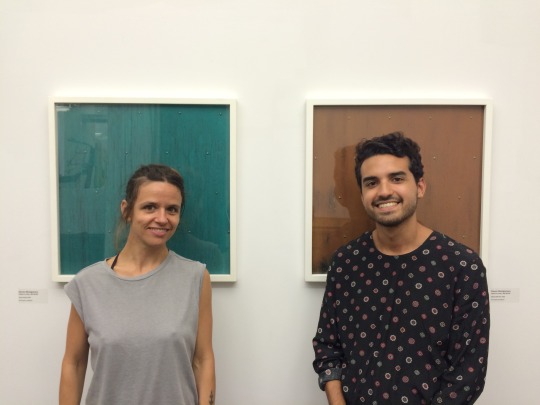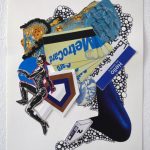IAP Interview: Valentina Medda & Stephano Espinoza
“You have this new persona that you can present to people and they will believe it. Like ‘Yeah, this is me!’”
Immigrant Artist Program (IAP) Mentor Valentina Medda arrived in New York in 2009/10 through a scholarship from the Italian government to study at the International Center for Photography (ICP). After an almost three-year return to her native country of Italy, Valentina returned to NYC for a residency at the Flux Factory in Queens. Valentina’s practice is based on the relationship between bodies and the environment and she is particularly interested in finding ways to create a sense of belonging in the space live in.
Stephano Espinoza, IAP mentee, is originally from Ecuador and came to the U.S. when he was 12 years old. His work focuses strongly on the process of adapting to a new country and context. Currently he is working with immigrant communities in New York City and is bringing the aesthetic tools from art school to more grassroots organizations to see how they can be combined.
NYFA: Do you remember what your first impression was of New York or the United States?
Valentina Medda: I think if you get to New York when you’re older than 12 years of age you already have all these pictures of New York in your mind. You have a really weird feeling of thinking that you know the city because you have seen it so many times, but actually you don’t. This familiarity is probably the reason why from day one I always felt safe in this city. It was also about these moments of “oh yeah, the Guggenheim” and then finding out that the Guggenheim is so small.
Stephano Espinoza: I came to the US 12 years ago but not to NYC. I first moved to Tampa, FL. I had been to the States before but only on vacation. That involved a lot of shopping and going to Disneyland, it was the perfect image of the U.S. that we were taught in South America. I was always taught to look up to this culture and the great things that it offers you. So I was very excited when I first moved here, I thought I was just on an extended vacation. But after being at the mall for a few weekends consecutively and after being to Disney I thought “wait, this is not it.” What happened to the magic? It was a long process of adapting, of seeing things for what they were, more than for what my expectations of the place were.
Also, I went through a strong racializing process when I came here. In Ecuador if you are not indigenous or black, you are perceived as white. So, I thought I was white. And then I came here and I wasn’t white at all. My sense of who I am and what I represent to other people, what people’s prejudices of me are, totally shifted. It was a very shaking moment and I am still trying to figure out what happened. A lot of my work still has to do with that.
NYFA: Are there specific things that you can point to and say ‘these things are actually happening just because I’m an immigrant’?
SE: I think I started taking painting or arts seriously when I came here because in Ecuador you couldn’t pursue it as a career. When I came here and my art teachers in middle school said “You’re so talented. Do this!” I got really excited and started pursuing it. From the beginning my work has all been about my experience. A lot of it are very personal narratives about being queer, my sexuality and also being brown and then figuring out what that is. I am just now putting them into a larger context of visualization, of ethnicity, of class. While it was happening it was just my feelings, it was all very personal but then the personal is also political.
VM: I still don’t know if my practice has been shaped by the fact that I am an immigrant or by the fact that I always view myself as an outsider. I come from a small island in Italy and I was the first one to leave it. In Sardinia there is no need for you to leave, unless you really want to and that is what I always wanted. Here, I am an Italian woman from a first world country. It is a completely different concept if not for the fact that people sometimes think I am Argentinian. I probably do not have the same issues that other migrants have to face. For me it had always been more about perceiving things from an outside perspective.
NYFA: Valentina, you mention feeling like an outsider. Is there anything else that you think immigrant artists share?
VM: I think we have to distinguish here in terms of people coming from another country as adults and people who came here as children or teenagers and who studied here. Studying is a very peculiar experience in the way it shapes your personality. Here in New York artwork is all about selling yourself and being good at that. Coming here, I had to learn a completely different way of how to present myself to the world. This was very difficult but it is also what I find other artist friends struggle with. The other element would be the language, the daily difficulty to not only be understood but also to be taken seriously. Language is power. Coming from a degree in philosophy in Italy and finding myself speaking like a ten-year-old here is hard. This is something I talked to friends about who had the same experience and how frustrating it is. It has been and it still is.
SE: I think it is a lot of what Valentina is saying. Aside from the language difficulties you don’t have the network of people you had. Sometimes, you don’t have the mother, father, siblings or friends that you had that could help you. You get used to this feeling of independence but also this really lonely feeling that forces you to reflect a lot. It forces you to reevaluate yourself and what you do. You have a lot of time for yourself.
VM: Yes, and no one knows the person you were 10 years ago. There is no one that saw the process of you becoming who you are now. You constantly have this feeling of “you know me right now but you don’t know what I went through”, which can lead to a patronizing attitude. Or you have to constantly explain who you are. In terms of identity, the story that we tell each other can be very confusing and difficult. As immigrants we all share these experiences of how to start from zero.
SE: On the flipside, this can also be empowering. You have this new persona that you can present to people and they will believe it. Like “Yeah, this is me!”.
NYFA: What Americanism did you adapt? Or when do your friends comment that you’re being very American?
SE: I think that when I go back they just comment on all the words I forgot, as it has been 10 years. When I go back to visit my family they’ll say “Ah, you gringo.” Here in the U.S., I have learned to develop more of my own personal voice. Here people believe that what you do matters and how you feel is important and it should be validated. Going back to Ecuador, it is very community based, a lot of times you put others above yourself. My father has said, “Oh, you’ve become so individualistic.” It hurts, but I see how that has definitely changed. I am not saying that it is bad at all because I don’t know what I would have done in tough moments if I couldn’t have told myself that what I am going through is something valid and that it’s ok.
VM: The first night that I came back to Italy after two and a half years, I remember seeing someone that I didn’t know that well. I remember I told her “I miss you” in Italian. Just “I miss you”, something that we say here all the time. Later, after a few months she told me “that one time that you told me ‘I miss you’ I was so confused.” She actually became a good friend. But it is true, we would never say something like that in Italian unless it is someone you’re in a relationship with.
NYFA: What do you miss most about home?
VM: I miss my old friends the most. People that have known me very well for a long time. It’s more of a romantic idea because a lot of my friends moved to other Italian cities. When I am back in Italy I am going to a specific city and a lot of them are not there anymore. But yes, people that I don’t need to explain myself with and I can just watch a movie with them without having to talk or explain what is going on in my mind. I miss that kind of mutual support and understanding.
SE: I think it would be my family. I moved to the States with my mom and she is still living here but all my siblings and nieces and nephews are in Ecuador.
VM: And the food! And the beach! Where I come from the sea is beautiful. Another thing would be the language. As much as I like speaking other languages but sometimes there are moments where I wake up and there is no way I can speak English. I have to make such an effort to put words together. My brain refuses, it thinks in Italian, it wants to talk in Italian. But No!
Stephano Espinoza and fellow artist Gabriela Espinosa are organizing a residency program TrueQue for emerging artists, activists and cultural organizers that live in or are part of the Latin American and Caribbean diaspora. They seek to generate a space for creative exploration in which research, the formation of networks and interdisciplinary work are fundamental in the process of art making. The residency will take place in Manabi – Ayampe, Ecuador from February 10 – 22, 2016. The deadline to apply is January 4, 2016.
Valentina Medda is currently working on Cities by Night, an ongoing project dealing with the perception of the danger experienced by solitary women wandering the streets at night. By showing the reduced mobility of a woman in the urban environment, the project questions the gendered nature of the public space and the role played by prejudices and stereotypes in our perception of danger and safety. It will be presented in Amsterdam in February, at Kulter, as one of the winning projects from T.I.N.A. Art Prize.
For more information on the Immigrant Artist Mentoring Program click here and to sign up to the monthly Con Edison IAP Newsletter to receive opportunities and events as well as artist features directly into your inbox, click here.
– Mara Vlatkovic, Digital Communications Officer
Image: Valentina Medda (left) and Stephano Espinoza (right), photo credit: Mara Vlatkovic




